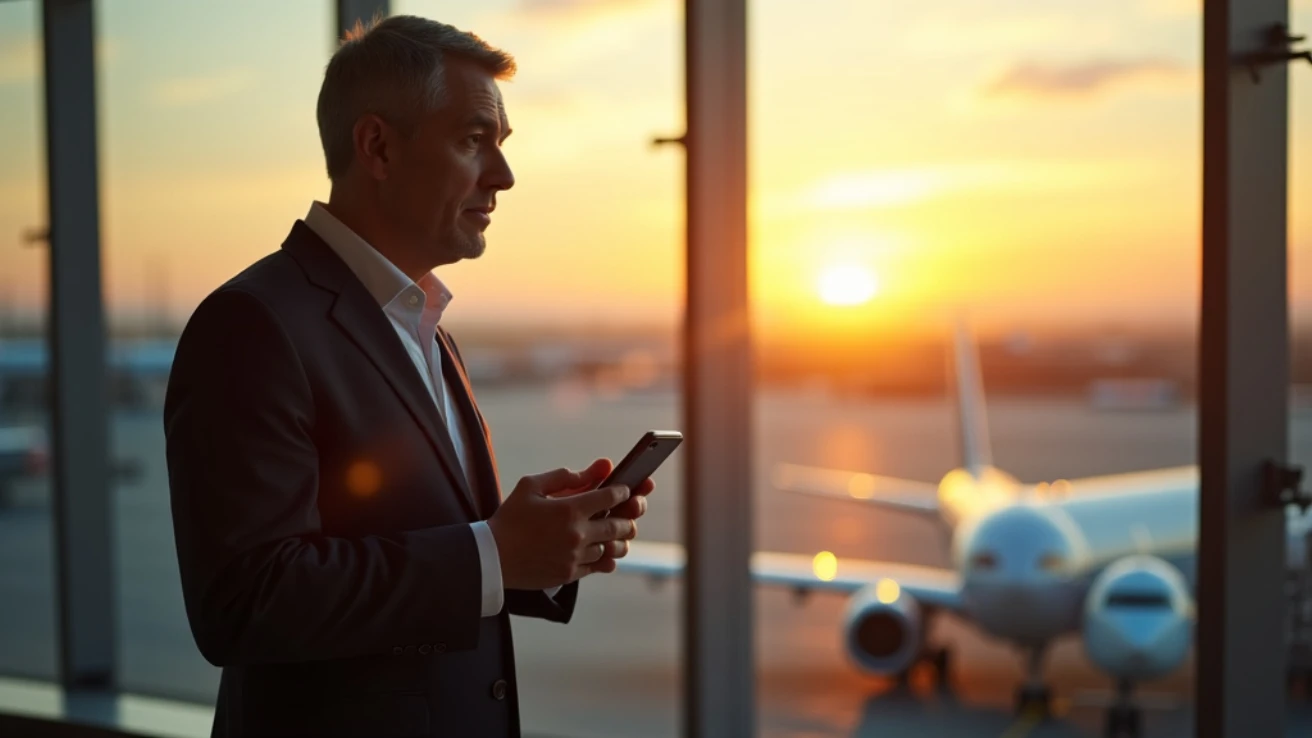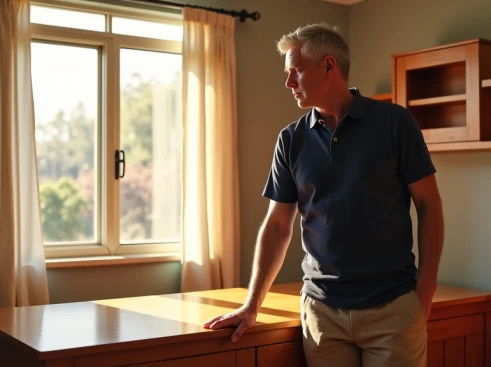That familiar ache in your chest as you watch her walk through the airport security gate, knowing it’ll be months before you hold her again. For countless men in long-distance relationships, this scene plays out with profound emotional weight.
As someone who’s counseled men through the unique challenges of loving from afar, I’ve witnessed both the heartache and inspiring triumphs. The truth is, physical distance doesn’t have to mean emotional distance.
When I connect with men in long-distance partnerships, one thing becomes crystal clear – the old ‘out of sight, out of mind’ mentality falls short. Modern relationships demand a deeper understanding of connection, trust, and commitment.
According to research from relationship experts, the success of long-distance relationships depends not on the miles between partners, but on the intentional effort to maintain emotional intimacy despite the physical separation.
Let’s explore how men can build stronger, more resilient long-distance relationships.
Effective Communication Strategies

Maintaining a thriving long-distance relationship requires consistent, meaningful communication. From my experience working with countless couples, I’ve discovered that successful long-distance partners treat communication as their relationship’s lifeline.
According to a recent study, couples who engage in responsive and frequent texting report significantly higher relationship satisfaction. The key lies not in message quantity, but in creating meaningful connections across the miles.
Establishing Communication Rhythms
Finding your communication sweet spot takes time and intentional effort. Some couples thrive on multiple daily check-ins, while others prefer fewer but longer, more in-depth conversations.
Rather than forcing rigid schedules, I recommend creating flexible routines that respect both partners’ natural rhythms. Regular good morning and goodnight texts serve as vital touchpoints that maintain daily connection.
Being present during video or voice calls makes an enormous difference. Put away distractions and give your partner your undivided attention, just as you would during an in-person conversation.
Quality Over Quantity
I’ve noticed many couples fall into the trap of constant but shallow communication. Instead, focus on meaningful exchanges that strengthen your emotional bond.
Share the small details of your day – that funny interaction with a coworker or the new coffee shop you discovered. These seemingly mundane moments help create shared experiences despite the distance.
When discussing important matters, opt for video calls where you can pick up on facial expressions and body language. This added layer of connection helps prevent misunderstandings that often arise in long-distance relationships.
Managing Time Differences and Schedules
Coordinating across different time zones and conflicting schedules presents a significant challenge for long-distance couples. The solution lies in being proactive and transparent about your availability.
A simple “Hey, I’ll be busy with meetings today, but I’d love to catch up during my lunch break” goes a long way in managing expectations. It shows you’re prioritizing the relationship while respecting both partners’ time.
Consider using shared calendars or scheduling apps to find optimal times for meaningful connection. This practical approach helps ensure quality time together without adding unnecessary stress.
Building and Maintaining Trust
Trust forms the bedrock of any successful long-distance relationship. Without the luxury of daily physical presence, couples must rely heavily on emotional bonds and unwavering faith in their connection.
Through counseling countless long-distance couples, I’ve observed that transparency serves as the cornerstone of trust-building. When partners openly share their daily experiences, struggles, and celebrations, they create an environment of authentic connection.
Trust resembles a delicate plant that requires consistent nurturing. Just as you wouldn’t water a plant sporadically and expect it to thrive, you can’t nurture trust through inconsistent communication or half-hearted efforts.
Creating a Foundation of Transparency
According to relationship experts at Marriage.com, successful long-distance couples prioritize honest communication above all else. This means sharing both the highlights and challenges of your day.
Set aside dedicated time for meaningful conversations beyond superficial check-ins. Whether through video calls or voice messages, make your partner feel included in your world.
I’ve found that couples who establish clear communication patterns – like scheduled daily check-ins or weekly video dates – build trust more effectively than those who leave things to chance.
| Communication Pattern | Description |
|---|---|
| Start with ‘why’ | Lead with the reasons behind a decision to guide listeners to a logical conclusion. |
| Show vulnerability, then vision | Express vulnerability to create connection, followed by sharing a vision for direction. |
| Use the NVC format | Structure requests with observations, emotions, needs, and requests for clarity. |
| Stick to the 40-word rule | Communicate key points succinctly in 40 words or less to ensure clarity. |
| Tell a story | Use storytelling to engage emotions and illustrate points effectively. |
| Ask for permission | Empower others by seeking permission before providing feedback or making changes. |
| Ask questions | Use open, simple, curious questions to coach and engage others in problem-solving. |
| Say ‘yes and…’ | Encourage creativity by building on ideas rather than dismissing them with ‘no, but…’. |
| Empathize first | Handle objections by empathizing with feelings before providing evidence. |
| Be the last to speak | Listen to others first in discussions to gain information and acknowledge contributions. |
Addressing Insecurities and Jealousy
Jealousy can surface in any relationship, but distance often intensifies these feelings. Don’t ignore these emotions; address them openly with your partner.
Create a safe space where both partners can express their vulnerabilities without fear of judgment. Often, acknowledging these feelings diminishes their power over the relationship.
Remember that trust isn’t about controlling your partner’s actions – it’s about having faith in their commitment to your shared relationship values.
Maintaining Consistency in Actions
Words matter, but actions speak volumes. Follow through on your commitments, whether it’s calling when you say you will or keeping promises about visit dates.
Small, consistent actions build reliability over time. Something as simple as sending a good morning text daily can create a pattern of dependability that strengthens trust.
When mistakes occur (because they will), own up to them quickly and sincerely. Nothing erodes trust faster than attempting to hide or minimize breaches of trust.
Respecting Boundaries and Independence
Trust flourishes when partners respect each other’s autonomy. Resist the urge to demand constant updates or monitor your partner’s social media activities obsessively.
Encourage each other’s individual growth and celebrate personal achievements. A strong relationship consists of two whole individuals choosing to share their lives.
Remember that trust is earned through consistent actions over time – there are no shortcuts to building lasting trust in a long-distance relationship.
Emotional Challenges and Coping Mechanisms

Managing a long-distance relationship requires extraordinary emotional resilience. As someone who’s counseled countless couples through the ups and downs of LDRs, I’ve seen firsthand how physical separation triggers intense feelings of loneliness, anxiety, and uncertainty.
The ache of missing your partner’s physical presence can feel overwhelming. According to research from relationship experts, this emotional toll manifests as persistent sadness, changes in sleep patterns, and difficulty concentrating.
Embracing Healthy Coping Strategies
I’ve found that successful LDR couples develop robust emotional toolkits. Start by establishing a consistent communication routine that works for both partners – whether it’s morning video calls or evening check-ins.
Regular exercise, meditation, and time in nature can work wonders for managing anxiety. These activities release endorphins and help maintain emotional balance during periods of separation.
Don’t underestimate the power of maintaining your individual identity. Throw yourself into work projects, pursue new hobbies, or spend quality time with friends. This isn’t about distraction – it’s about personal growth alongside your relationship.
Building Trust Through Uncertainty
Let’s be honest – trust issues can emerge when you’re miles apart. The key is accepting that uncertainty is normal while maintaining open, honest dialogue about your feelings and concerns.
Create shared rituals that bridge the distance. Watch movies together virtually, read the same book, or send care packages. These shared experiences foster emotional intimacy despite the physical gap.
Remember that having tough days is perfectly normal. Acknowledging your feelings rather than suppressing them strengthens emotional resilience over time.
Nurturing Connection While Apart
I always remind couples that emotional intimacy isn’t dependent on physical proximity. Focus on quality communication – share your dreams, fears, and daily experiences with genuine vulnerability.
Keep a private journal to process your emotions. Writing provides therapeutic relief when navigating the complexities of long-distance love.
Build a support network of friends who understand your situation. Having others acknowledge the unique challenges of LDRs can help you feel more understood in your experience.
Planning for the Future Together
The emotional toll of physical separation in a long-distance relationship can feel overwhelming at times. I’ve learned through both personal experience and professional research that having a clear shared vision serves as the cornerstone for making it work.
A study published in InterNations Guide emphasizes that long-distance relationships require an endgame – a concrete plan for eventually being together physically. Without this vital component, couples often struggle to maintain hope and motivation.
Setting Clear Goals and Timelines
The first step in crafting your shared future involves honest discussions about individual and collective aspirations. Where do you see yourselves living? What career paths are you pursuing? These conversations, though challenging, help establish mutual understanding and commitment.
Remember that goals should be SMART – Specific, Measurable, Achievable, Relevant, and Time-bound. Instead of vague intentions like ‘moving in together someday,’ set concrete milestones: ‘We plan to close the distance within 18 months after graduation.’
Long-term planning requires examining practical considerations. Research visa requirements, job markets, and cost of living in potential cities where you might settle together. This groundwork transforms abstract dreams into actionable plans.
Navigating Career Decisions Together
Career paths often present the biggest challenge in closing the distance. You’ll need to evaluate whose career offers more flexibility for relocation and whether remote work options exist. Sometimes, this means making difficult compromises.
Consider creating a shared spreadsheet to track job opportunities, living costs, and potential timelines in different cities. This practical approach keeps both partners engaged in the planning process while maintaining transparency about progress and challenges.
When evaluating career moves, remember that temporary sacrifices might be necessary for long-term happiness. However, ensure that neither partner’s professional growth is completely sidelined.
Building Financial Foundations
Moving costs, visa applications, and establishing a new home together require substantial financial planning. Start saving early and create a realistic budget that accounts for all potential expenses in your transition plan.
Consider opening a joint savings account specifically for reunion-related expenses. This tangible commitment to your shared future can strengthen your resolve during challenging times and provide a clear metric of progress.
Track your monthly savings goals and celebrate when you reach important financial milestones together. These small victories maintain momentum toward your ultimate goal of closing the distance.
Maintaining Emotional Connection While Planning
Throughout the planning process, it’s crucial to nurture your emotional bond. Schedule regular check-ins focused on discussing progress, adjusting plans, and supporting each other through uncertainties.
Share your individual concerns openly and address them together. If one partner feels anxious about the timeline or specific aspects of the plan, create space for honest dialogue without judgment.
Remember that setbacks are normal and don’t reflect on the strength of your relationship. Stay flexible and be prepared to adjust your plans as circumstances change.
Maintaining Intimacy from Afar

Physical separation poses unique challenges for couples in long-distance relationships, yet technology and creativity provide rich opportunities for maintaining meaningful connections. Smart use of digital tools offers effective ways to bridge the distance between partners.
Research from the Office of Family Assistance reveals that over 3 million Americans live apart from their spouses for reasons unrelated to conflict, highlighting how common and manageable long-distance relationships can be.
Building Emotional Intimacy
The foundation of lasting intimacy begins with consistent, meaningful communication. Regular check-ins through video calls or voice messages strengthen emotional bonds and demonstrate commitment to the relationship.
I’ve found that scheduling dedicated “date nights” adds structure and anticipation to long-distance relationships. Set aside uninterrupted time for deep conversations, shared activities, or simply being present together virtually.
Create special rituals unique to your relationship – perhaps reading the same book and discussing it weekly, or watching sunsets together via video chat. These shared experiences foster intimacy through common ground.
Nurturing Physical Connection
While physical distance creates natural limitations, couples can maintain sensual connection through creative approaches. Exchange handwritten love letters expressing desire and appreciation for your partner’s physical qualities.
Share intimate photos (maintaining appropriate boundaries) or engage in private video calls to preserve that spark. The anticipation of reunion can enhance attraction when approached thoughtfully.
Consider sending care packages with personal items carrying your scent, or objects that provide tactile comfort in your absence. These physical tokens help bridge the intimacy gap between visits.
Leveraging Technology Mindfully
Digital tools enable numerous ways to feel closer, from synchronized movie watching to virtual cooking dates. Remember to prevent screens from becoming barriers to genuine connection.
Vary your communication methods – voice memos capture tone and emotion differently than texts, while video allows you to share facial expressions and body language essential for intimacy.
Use apps designed specifically for long-distance couples to share moments, count down to visits, or simulate physical touch through paired devices. Ensure technology enhances rather than substitutes authentic connection.
| Method | Percentage of Use | Comments |
|---|---|---|
| Sending care packages or thoughtful gifts | 74% | Helps show love and affection |
| Daily texting | 88% | Ensures constant contact throughout the day |
| Video calls | Common | Average couple spends 8 hours a week on platforms like Zoom |
| Trust as foundation | 85% | Considered critical for success |
| Open communication | 82% | Emphasized as important for relationship success |
| Planning visits | 30% more likely | Couples with a concrete timeline for closing the distance are more likely to stay together |
Thriving in Long Distance Love
The journey of maintaining a long-distance relationship isn’t always smooth sailing, but as countless successful couples have shown, the rewards can far outweigh the challenges. Research shows that many couples actually point to their season of long distance as the cornerstone of a stronger relationship.
I’ve witnessed firsthand how distance can forge deeper emotional connections and build unshakeable trust between partners. When physically apart, couples learn to cherish every moment together and develop communication skills that many traditional couples never master.
Looking back at the essential strategies discussed, successful long-distance relationships thrive on clear expectations and consistent communication. Don’t feel pressured to talk for hours each day – quality always trumps quantity when staying connected.
Trust your journey and embrace the growth opportunities that distance presents. Whether separated by a few hours or several time zones, focus on building meaningful shared experiences, even from afar. Watch movies together virtually, send surprise care packages, or plan regular video date nights.
Most importantly, keep your eyes on the future you’re building together. The temporary separation becomes more manageable when you have concrete plans and milestones to work toward. Your dedication today paves the way for a stronger tomorrow.
While the path may feel challenging at times, remember that distance is merely a test of your commitment, not a barrier to your love. Stay patient, keep faith in your connection, and continue investing in your shared future – the reunion will be worth every moment apart.







